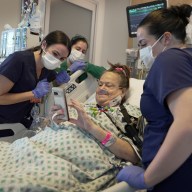Nothing ruins a lovely Thanksgiving dinner than a trip to the ER. Prepare your meal safely with these tips from Randy Worobo, a food safety expert and a professor of Food Science in Cornell University’s College of Agriculture and Life Sciences.
- Never thaw your turkey at room temperature. Thaw in the refrigerator. It takes approximately one day for every four to five pounds of turkey to thaw at refrigerated temperatures. When thawing in the refrigerator, place the frozen turkey in a pan that will catch the condensate and any potentially contaminated liquids from the turkey. Place the turkey on the lowest shelf of your fridge to avoid any spilling of contaminated condensate onto other foods in your refrigerator. Alternatively, you can thaw your turkey in a sanitized sink with continual running cold water or changing the water on a regular basis (every 30 minutes). If you are buying a fresh turkey, keep it refrigerated until you are ready to prepare and cook.
- Wash your hands thoroughly with warm water and soap for 20 seconds before and after handling the turkey.
- Sanitize any utensils and surfaces with prepared disinfectant or a dilute solution of unscented bleach (one-half tablespoon in one gallon of water). Avoid cross contamination of other foods that will be consumed raw, such as salads, by contaminated surfaces and utensils.
- If brining your turkey prior to cooking, make sure that the brine is 40 degrees or lower. Then place the turkey and brine in a refrigerator for the desired brining time. Discard the brine immediately after the brining period is complete. Avoid splashes when disposing of the brine and resanitize your sink if you dispose of it down your kitchen sink.
- If you are stuffing your turkey, prepare the stuffing just before the turkey is ready to go into the oven. The stuffing must be cooked to a minimum temperature of 165 degrees. For enhanced safety, it is recommended to cook your stuffing in a separate container.
- Cook the turkey to a minimum internal temperature of 165 degrees. Measure the temperature with a thermometer in the thickest part of the breast and thigh without touching the bone. If it is below 165 degrees, place the turkey back into the oven and continue to cook until the thermometer reads greater than 165 degrees. If the turkey is stuffed, the center portion of the stuffing must reach a minimum of 165 degrees.
- Keep the remaining turkey at greater than 140 degrees, or refrigerate the leftovers within two hours after the turkey has finished cooking. Refrigerate the leftovers so that it reaches 40 degrees or lower within 6 hours. To assist in the rapid cooling, remove all the stuffing from the interior cavity of the bird and cut the remaining turkey into smaller portions and cool in shallow containers that are vented.
- Reheat your leftovers to a minimum of 165 degrees for 15 seconds to inactivate any potential p
 athogens that may have contaminated the food after cooking.
athogens that may have contaminated the food after cooking.
















